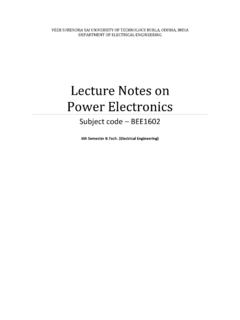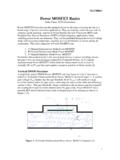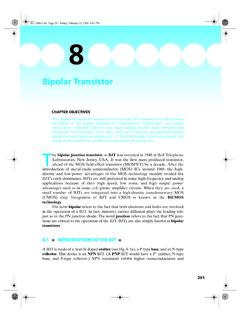Transcription of Power MOSFET Basics - Tayloredge
1 Power MOSFET BasicsVrej Barkhordarian, International Rectifier, El Segundo, Power MOSFET semploy semiconductorprocessing techniques that aresimilar to those of today's VLSI circuits, although the devicegeometry, voltage and currentlevels are significantly differentfrom the design used in VLSI devices. The metal oxidesemiconductor field effecttransistor ( MOSFET ) is basedon the original field-effecttransistor introduced in the70s. Figure 1 shows thedevice schematic, transfercharacteristics and devicesymbol for a MOSFET . Theinvention of the powerMOSFET was partly driven bythe limitations of bipolar powerjunction transistors (BJTs)which, until recently, was thedevice of choice in powerelectronics applications.
2 Although it is not possible todefine absolutely the operatingboundaries of a Power device,we will loosely refer to thepower device as any devicethat can switch at least bipolar Power transistor isa current controlled device. Alarge base drive current ashigh as one-fifth of thecollector current is required tokeep the device in the , higher reverse base drivecurrents are required to obtainfast turn-off. Despite the very advanced state of manufacturability and lower costs of BJTs, theselimitations have made the base drive circuit design more complicated and hence more expensive than thepower * Drainp-SubstrateChanneln* SourcetoxlVGSVT00ID(a)(b)IDDSB(Channel or Substrate)SG(c)Figure 1.
3 Power MOSFET (a) Schematic, (b) Transfer Characteristics, (c)Device BJT limitation is that both electrons and holescontribute to conduction. Presence of holes with their highercarrier lifetime causes the switching speed to be several orders ofmagnitude slower than for a Power MOSFET of similar size andvoltage rating. Also, BJTs suffer from thermal runaway. Theirforward voltage drop decreases with increasing temperaturecausing diversion of current to a single device when severaldevices are paralleled. Power mosfets , on the other hand, aremajority carrier devices with no minority carrier injection.
4 Theyare superior to the BJTs in high frequency applications whereswitching Power losses are important. Plus, they can withstandsimultaneous application of high current and voltage withoutundergoing destructive failure due to second breakdown. PowerMOSFETs can also be paralleled easily because the forwardvoltage drop increases with increasing temperature, ensuring an even distribution of current among , at high breakdown voltages (>200V) the on-state voltage drop of the Power MOSFET becomeshigher than that of a similar size bipolar device with similar voltage rating. This makes it more attractiveto use the bipolar Power transistor at the expense of worse high frequency performance.
5 Figure 2 showsthe present current-voltage limitations of Power mosfets and BJTs. Over time, new materials,structures and processing techniques are expected to raise these Current (A)Holdoff Voltage (V)BipolarTransistorsMOSF igure 2. Current-VoltageLimitations of mosfets and + Substrate(100)n- Epi LayerChannelsn+pn+p+ Body Regionp+Drift RegionGSDS ourceGateOxidePolysiliconGateSourceMetal lizationFigure 3. Schematic Diagram for an n-Channel Power MOSFET and the 3 shows schematic diagram and Figure 4 shows the physical origin of the parasitic components inan n-channel Power MOSFET . The parasitic JFET appearing between the two body implants restrictscurrent flow when the depletion widths of the two adjacent body diodes extend into the drift region withincreasing drain voltage.
6 The parasitic BJT can make the device susceptible to unwanted device turn-onand premature breakdown. The base resistance RB must be minimized through careful design of thedoping and distance under the source region. There are several parasitic capacitances associated withthe Power MOSFET as shown in Figure is the capacitance due to the overlap of the source and the channel regions by the polysilicon gateand is independent of applied voltage. CGD consists of two parts, the first is the capacitance associatedwith the overlap of the polysilicon gate and the silicon underneath in the JFET region.
7 The second part isthe capacitance associated with the depletion region immediately under the gate. CGD is a nonlinearfunction of voltage. Finally, CDS, the capacitance associated with the body-drift diode, varies inverselywith the square root of the drain-source bias. There are currently two designs of Power mosfets , usuallyreferred to as the planar and the trench designs. The planar design has already been introduced in theschematic of Figure 3. Two variations of the trench Power MOSFET are shown Figure 5. The trenchtechnology has the advantage of higher cell density but is more difficult to manufacture than the Epi Layern- SubstrateFigure 4.
8 Power MOSFET Parasitic VOLTAGEB reakdown voltage,BVDSS, is the voltage atwhich the reverse-biasedbody-drift diode breaksdown and significantcurrent starts to flowbetween the source anddrain by the avalanchemultiplication process,while the gate andsource are shortedtogether. Current-voltagecharacteristics of apower MOSFET areshown in Figure is normallymeasured at 250 A draincurrent. For drainvoltages below BVDSSand with no bias on thegate, no channel isformed under the gate atthe surface and the drainvoltage is entirelysupported by thereverse-biased body-driftp-n junction. Two relatedphenomena can occur inpoorly designed andprocessed devices:punch-through andreach-through.
9 Punch-through is observedwhen the depletionregion on the source sideof the body-drift p-njunction reaches thesource region at drainvoltages below the ratedavalanche voltage of thedevice. This provides acurrent path betweensource and drain andcauses a soft breakdowncharacteristics as shownin Figure 7. The leakagecurrent flowing betweensource and drain is denoted by IDSS. There are tradeoffs to be made between RDS(on) that requires shorterchannel lengths and punch-through avoidance that requires longer channel reach-through phenomenon occurs when the depletion region on the drift side of the body-drift p-njunction reaches the epilayer-substrate interface before avalanching takes place in the epi.
10 Once thedepletion edge enters the high carrier concentration substrate, a further increase in drain voltage willcause the electric field to quickly reach the critical value of 2x105 V/cm where avalanching Epi Layern+ Substrate(100)Drain(b)GSSE lectron FlowD(a)Figure 5. Trench MOSFET (a) Current Crowding in V-Groove Trench MOSFET ,(b) Truncated V-Groove MOSFETON-RESISTANCEThe on-state resistance of a Power MOSFET is made up of several components as shown in Figure 8:(1)where:Rsource = Source diffusion resistanceRch = Channel resistanceRA = Accumulation resistanceRJ = "JFET" component-resistance of theregion between the two body regionsRD = Drift region resistanceRsub = Substrate resistanceWafers with substrate resistivities of up to20m -cm are used for high voltagedevices and less than 5m -cm for lowvoltage = Sum of Bond Wire resistance, theContact resistance between the sourceand drain Metallization and the silicon,metallization and Leadframecontributions.










